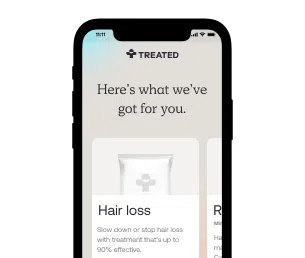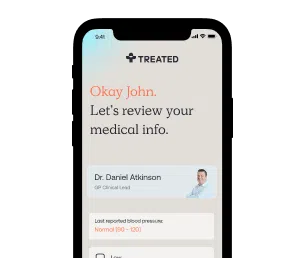Urinary incontinence
Tablets and capsules to control your bladder.
Secure delivery
UK clinicians
Urinary incontinence can cause embarrassment and disruption to your everyday life. Medications and therapies can help to treat it.
Answer a few questions about your health, and get treatment recommendations from our experts. Order urinary incontinence treatment online, on subscription.
Urinary incontinence is when you lose control of your bladder. It can cause you to accidentally release a small amount of urine or to completely empty your bladder. There are several different types of it, and both men and women can develop urinary continence for a variety of reasons.
You may feel a bit embarrassed about it, but it’s pretty common, and a clinician can usually help you to address it. If you’re experiencing urinary incontinence for the first time, a clinician will need to evaluate you to make sure you don’t have an underlying condition.
Women are about twice as likely to suffer from urinary incontinence as men. Your risk of developing it increases with age, and a family history of urinary incontinence also increases your risk.
Women are more likely to develop urinary incontinence during pregnancy. A growing fetus puts pressure on the bladder, making it harder for pregnant women to control it. Women who are postpartum also have higher rates of urinary incontinence because giving birth can damage or weaken the muscles involved in urinating.
Obesity can increase your risk of urinary incontinence too. The additional weight carried by obese people may stress their bladder, leading to a loss of control over the urinary sphincter. There are also other conditions that may cause it, including neurodegenerative diseases like Parkinson’s disease and multiple sclerosis.
In population-based research, the number of people who experience urinary incontinence ranges from just under 10% to 36%, and more than twice the amount of older women have it than older men. Despite the large number of people who experience urine leakage, it’s not often discussed because of embarrassment. It’s a sensitive subject, but many people would benefit from discussing it with a clinician. Once you’ve spoken to a clinician about it, they can explore treatment options with you to either reduce the number of times you experience urinary incontinence or help it to stop altogether.
There are five different types of urinary incontinence: stress, urge, overflow, functional and mixed incontinence. The two most common types are stress urinary incontinence and urge urinary incontinence.
Stress urinary incontinence (SUI) happens when there’s pressure on your bladder from the muscles around it. This pressure is stronger than your bladder control muscles, so urine leaks through your urinary sphincter.
Urge urinary incontinence (UUI) happens when you get a sudden urge to urinate that you can’t control. Your bladder responds by releasing itself involuntarily. There are usually underlying conditions that cause this sort of incontinence, but they’re mostly minor.
Functional urinary incontinence happens when you experience a physical or mental issue that prevents you from reaching the bathroom before your bladder relieves itself. A physical condition that makes it hard for you to remove your clothes or a mental condition that stops you from responding to your urge to urinate appropriately indicates functional incontinence.
Overflow urinary incontinence is characterised by small amounts of urine that escape throughout the day. If you don’t fully empty your bladder when you go to the bathroom, it can lead to overflow incontinence.
Mixed urinary incontinence is when your urinary incontinence symptoms mirror more than one kind of urinary incontinence. You may experience a combination of stress urinary incontinence and urge urinary incontinence symptoms.
Stress incontinence is the result of pressure on your bladder from the muscles around it. Many pregnant women experience stress incontinence because of the weight of the growing fetus and from the kicks and jabs as it moves around in the uterus. Other people may leak urine when they have abdominal spasms that result from laughing, coughing, or sneezing.
Urge incontinence is different from stress incontinence. People who have this type of urinary incontinence get sudden, strong urges to urinate. The urge is so strong that they can’t make it to the bathroom before their bladder releases urine. Drinking caffeine or alcohol can cause urge incontinence, but there may also be an underlying condition that’s causing it.
People who show signs of more than one type of urinary incontinence are diagnosed with mixed incontinence. If you suffer from two or more types of urinary incontinence, talk to our clinician to figure out why you have mixed incontinence and how to treat it.

How we source info.
When we present you with stats, data, opinion or a consensus, we’ll tell you where this came from. And we’ll only present data as clinically reliable if it’s come from a reputable source, such as a state or government-funded health body, a peer-reviewed medical journal, or a recognised analytics or data body. Read more in our editorial policy.
No matter which type of urinary incontinence you have, it’s often a result of weakening in the muscles of the bladder. Weakening can occur as you age, but it can also be an outcome from pregnancy, birth, menopause, or obesity.
The symptoms of urinary incontinence are fairly consistent between people. They may include any of the following:
Urinary incontinence can be a sign of a more serious condition on rare occasions. Usually, it’s a temporary condition that affects your everyday life until it’s resolved, but it isn’t necessarily an indication of a severe or life-threatening condition.

How we source info.
When we present you with stats, data, opinion or a consensus, we’ll tell you where this came from. And we’ll only present data as clinically reliable if it’s come from a reputable source, such as a state or government-funded health body, a peer-reviewed medical journal, or a recognised analytics or data body. Read more in our editorial policy.

How we source info.
When we present you with stats, data, opinion or a consensus, we’ll tell you where this came from. And we’ll only present data as clinically reliable if it’s come from a reputable source, such as a state or government-funded health body, a peer-reviewed medical journal, or a recognised analytics or data body. Read more in our editorial policy.
Have something specific you want to know? Search our info below, or ask our experts a question if you can’t find what you’re looking for.
[online] Available at:
Diagnosis, Evaluation, and Treatment of Mixed Urinary Incontinence in Women. Reviews in Urology, [online] 17(2), pp.78–83. Available at:
Overview - Urinary incontinence. [online] NHS. Available at:
Diagnosis - Urinary incontinence. [online] Available at:

Branded treatment that can help your symptoms in four weeks. Available in three different strengths.

Branded, delayed-release oxybutynin. Only one tablet per day, for full protection.

Treats symptoms of urinary incontinence within two weeks. The generic version of Lyrinel XL.

With just one capsule a day, you can take back control of your bladder.

Generic version of Vesicare. Tablets to treat an overactive bladder.

Tablets to help relax your bladder muscles and treat incontinence.

Registered with GMC (No. 4624794)
Meet Daniel
Registered with GPhC (No. 2202465)
Meet Sanjeda
Registered with GPhC (No. 2070724)
Meet Craig
Always read the leaflet that comes with your medication and tell us about any side effects you get.
We know health, but you know you.
Our experts tell you what’s safe, but you decide what’s best.
Answer a few questions and tell us about yourself. Get tailored advice from our clinicians so you can choose better.

Choose your treatment and how often you have it delivered.

We know things change. It’s the nature of life. We’ll check in regularly to make sure your treatment is still right for you.
Pause. Change. Skip. Start again. Any time you like.
Here are some other things we can help with.
Personalised advice. Effective antibiotic treatments to restore balance. Get the help you need for BV.
Pill, patch, ring. We offer a range of birth control options so you can choose the one that's right for you.
Treatments to make your period lighter and more manageable. We'll help you to find the right option for you.
Prevent unplanned pregnancy with emergency contraception. Highly effective Plan B treatments, delivered fast.
Event planned? Period due? Take period delay pills a few days before to delay your bleeding.
Tablets, pessaries. Chat to our clinicians to get confidential advice and treatment for yeast infections.
We're making healthcare more about you. Sign up to our newsletter for personalised health articles that make a difference.
Disclaimer: The information provided on this page is not a substitute for professional medical advice, diagnosis, or treatment. If you have any questions or concerns about your health, please talk to a doctor.
We couldn't find what you're looking for.
Here's everything we treat. Or, if you're looking for something we don't have yet, you can suggest something.
If there’s a particular treatment or condition you’re looking for, tell us and we’ll look into it for you.
Submit your question here, or tell us if you’ve found an issue on our site.
We’ll get back to you very soon. We aim to respond to all queries in one working day.
You’re signed up to our newsletter. Keep an eye on your inbox for our latest update.
By clicking 'Subscribe now' you're agreeing to our Privacy Policy.
We’ve sent you an email asking you to confirm your email address.